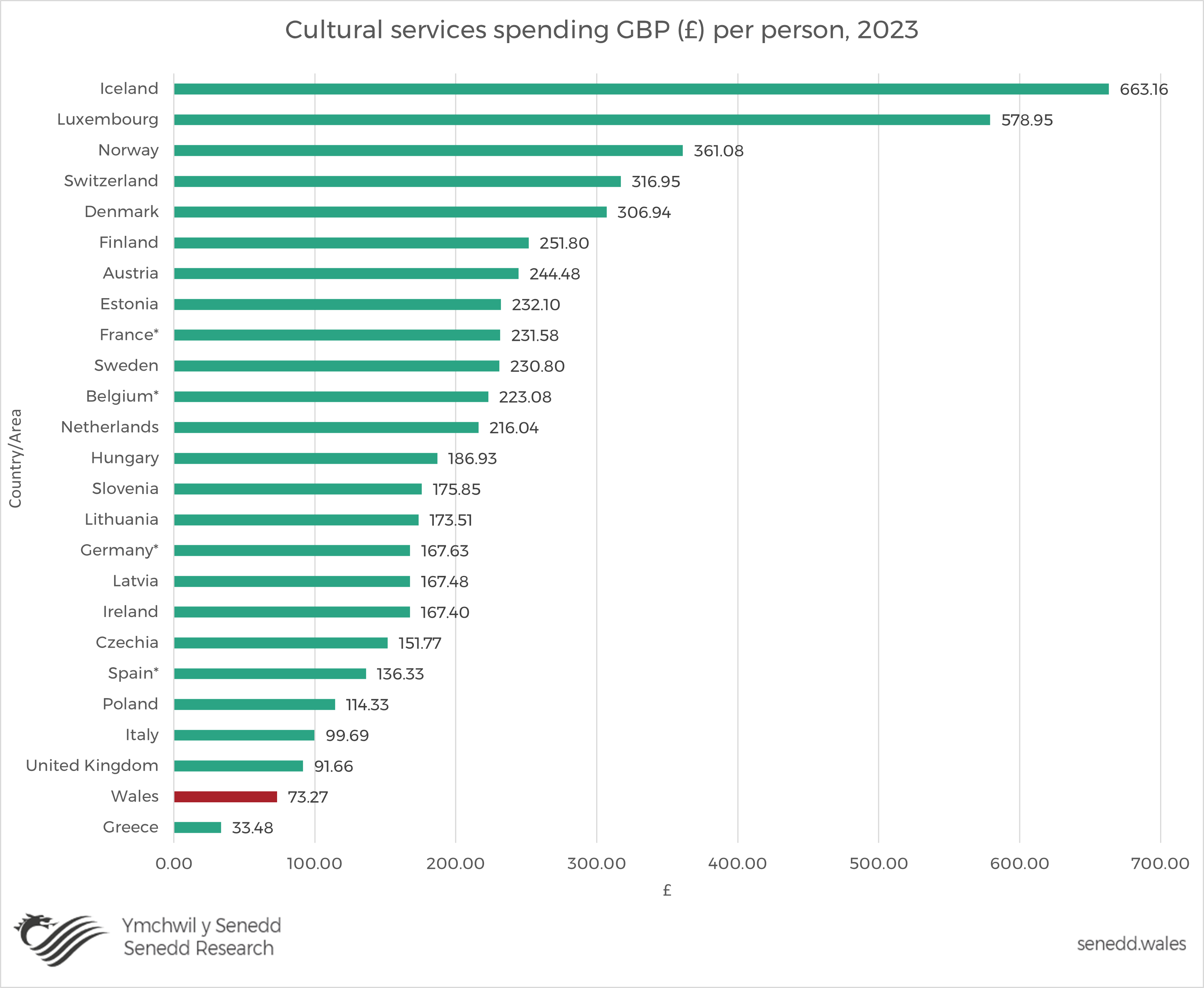On 22 October 2025 Plenary will debate the Culture, Communications, Welsh Language, Sport and International Relations Committee’s report into Charging for exhibitions.
Following reductions to culture in the Welsh Government’s 2024-25 Draft Budget, then Culture Minister, Dawn Bowden MS, said that ending free entry to Amgueddfa Cymru – which has been government policy since 2001 – was “on the table”. Although subsequently ruled out, this followed a decade of cuts which left funding for culture in Wales among the lowest in Europe.
The Senedd’s Culture, Communications, Welsh Language, Sport and International Relations Committee decided to investigate the free entry policy, alongside the impact of charging for access to exhibitions.
Funding for culture among the lowest in Europe
In 2024-25 the Welsh Government cut revenue funding for culture and sport by 7.7% compared to 2023-24 allocations, in a budget that saw funding swinging to health and social services. Capital funding, which is less than half the value of revenue allocations, increased by 6.3%.
This meant that, by its own calculations, the Welsh Government had reduced revenue budgets in these areas by 17% in real-terms over a decade. Over the same period, capital budgets (which are less than half the size of revenue budgets) almost tripled in size.
Following these prolonged real-terms reductions, public funding of culture in Wales is among the lowest in Europe. Analysis from Senedd Research compared public spending on culture and sport with 24 European countries (including the UK as a whole) for which data was available.

Source: Senedd Research analysis of Welsh Government, StatsWales and OECD data
The average spend on cultural services in these countries is £223.85 per person. In Wales the figure is £73.27 per person, also 33% of the average of these countries. This placed Wales second from bottom of the group of 25 nations.
The Welsh Government increased funding for culture in the 2025-26 Budget, though broadly this was just a reversal of reductions in the 2024-25 Budget.
Day-to-day revenue spending (that is, excluding non-cash) for Welsh Government funded culture and heritage bodies has increased by 2.1% between 2023-24 and the 2025-26 June Supplementary Budget. This is less than inflation, which was about 4% between 2023 and 2025.
Amgueddfa Cymru (Museum Wales) described the 2024-25 reductions as the “the biggest cuts to Amgueddfa Cymru's budget ever”. It responded by making 144 (or one in six) of its staff redundant and reducing winter opening hours.
“Culture bodies will need to explore other sources of income”
In January 2024, then Deputy Minister for Arts, Sport and Tourism, Dawn Bowden MS, told the Culture Committee that charging for access to Amgueddfa Cymru was “on the table” due to the “critical situation” regarding the budget. She stressed:
“I'm not saying that that's where we will end up, but it would not be responsible of me to rule that out at this stage or to suggest to the museum that they shouldn't be exploring that.”
The subsequent Culture Minister, Lesley Griffiths MS, ruled out charging for entry. But the Welsh Government had said that “culture bodies will need to explore other sources of income” to meet inflationary pressures”.
Free entry has increased visitor numbers, but requires adequate funding
Entrance to national museums across the UK has been free since 2001, when museums dropped charges in return for funding from governments.
According to Nia Elias at Amgueddfa Cymru, “when we offered free entry then the numbers of visitors doubled”. But the point that free entry does not, in and of itself, lead to equal socio-economic attendance at museums was made by Dr Mark O’Neil, former head of Glasgow Museums.
“The primary predictor of museum visiting isn't income, and charging isn't the most significant barrier”, he told the Committee. “The greatest predictor of museum visiting is the prior level of education.”
The Committee endorsed free-entry, but felt that the Welsh Government had not met its responsibility to adequately fund Amgueddfa Cymru for its provision. “It is an indictment of […] historic low levels of funding”, it said, “that the previous Deputy Minister for Arts, Sport and Tourism told this Committee that charging for entry was an option “on the table”. It called for free entry to remain Welsh Government policy, accompanied by “adequate funding” for Amgueddfa Cymru to facilitate this.
“Very few temporary shows make an absolute profit”
The Welsh Government ultimately ruled out scrapping free-entry. But can charging for individual exhibitions help museums plug the gaps caused by reduced real-terms government funding?
“Treasures: adventures in archaeology” was a charged-for exhibition held by the Amgueddfa in 2016. Once income (£116,000, including a Welsh Government grant of £45,000) has been subtracted from operating costs (£301,000), it cost the Amgueddfa £185,000 to put on. This was less than the projected cost, demonstrating that the Amgueddfa’s intent was for entry charges to subsidise the cost of the exhibition, not turn a profit.
As the 2017 Thurley Review into Amgueddfa Cymru noted: “very few temporary shows make an absolute profit”. The Committee concluded that “The Welsh Government should […] be wary of pointing to exhibitions as an answer to the problems caused by the Welsh Government’s underfunding of Amgueddfa Cymru”.
Going underground: will the public get what the public want?
Big Pit National Coal Museum, in Blaenavon, Torfaen, is part of Amgueddfa Cymru. The site offers underground tours led by former miners and apprentices, allowing visitors to explore the original mine shafts and see the machinery and tools used in coal extraction.
In 2024, Amgueddfa Cymru ran a trial charging for the underground tours. This followed a recommendation from the 2023 Tailored Review into the Amgueddfa, that it increased its commercial income, including from “special exhibitions and ‘visitor experience’ elements such as going underground at Big Pit”.
Amgueddfa Cymru’s Chief Executive discussed the charging trial with the Committee in December 2024. “The feedback on the underground tour charging at Big Pit is very positive”, she said. “Ninety-eight per cent of the people who responded […] said they would be happy to pay that or pay more.”
But the Committee thought that a decision to charge for the underground tours should be driven by principles, not data. These tours, it felt, provided an “invaluable insight into the central role of coal mining in Welsh history”, and “people should not have to pay to gain this insight into their own past.” The Welsh Government rejected the Committee’s recommendation that it should “make it clear that the principle of free entry to the national museum sites extends to the underground tour at Big Pit”.
The Government has stressed that the independence of Amgueddfa Cymru means that Ministers cannot dictate the charging policy at Big Pit. Yet the Welsh Government also refers its “continued commitment to the free entry policy” and provides over 80% of the Amgueddfa’s funding, which it spends according to a remit letter from the Welsh Government.
The Amgueddfa is an independent organisation. But this independence is constrained by the policy direction it receives, along with the bulk of its funding, from the Welsh Government.
The Committee said that “the Welsh Government is yet to fund culture in a way that recognises its intrinsic worth to the nation”. Will this change in a Draft Budget – set to be published on 3 November – which the Welsh Government has said will simply be the current year’s budget, increased in line with inflation?
Article by Robin Wilkinson, Senedd Research, Welsh Parliament.






